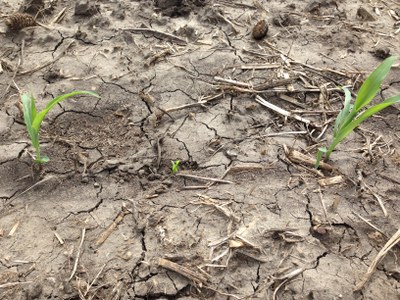Impact of Corn Plant Establishment on Grain Yield
 North Dakota State University conducted a statewide study in 2013-14 to evaluate the impact of corn plant establishment on grain yield. The study’s basic objective was to measure the yield response of late-emerging plants, plant doubles and plant skips compared to normally emerged and evenly spaced plants. This report will summarize highlights of the study conducted in Eddy, Foster and Wells counties using data from seven fields.
North Dakota State University conducted a statewide study in 2013-14 to evaluate the impact of corn plant establishment on grain yield. The study’s basic objective was to measure the yield response of late-emerging plants, plant doubles and plant skips compared to normally emerged and evenly spaced plants. This report will summarize highlights of the study conducted in Eddy, Foster and Wells counties using data from seven fields.
Commercial corn fields were selected for the study. Three plots were located within each field at or soon after planting, and consisted of 12 or 16 rows with a length of 30 feet. Data collected soon after planting included soil type, tillage system, soil moisture, type of corn planter, planter speed, row spacing, corn hybrid, planting date, planting depth, starter fertilizer and previous crop residue levels. Plant populations were measured at emergence and about 7 and 14 days after the initial emergence date. Also, plants emerging after general field emergence time were identified, as well as plant skips (plants with distance greater than 12 inches of one another within row) and plant doubles (plants within 2 inches of one another). In addition, corn rows were identified that had most and second-most, and least and second-least plant variability based on timing of plant emergence. At corn maturity, ears were hand-harvested from selected plants and rows to determine grain yield, moisture and test weight.
Table 1 summarizes early season data among the seven corn fields. Planting dates ranged from May 14 to June 2. Planting rate ranged from 30,000 to 36,000 seeds/A with a study average of 32,400 seeds/A. Plant population about a month after planting ranged from 26,100 to 33,700 plants/A with an average of 29,100 plants/A. Early season plant stand ranged from 4 to 25% less and averaged 10% less compared to the seed planting rate.
Table 2 summarizes harvest data among the seven corn fields. Each field contained plants that emerged about 1 to 3 weeks after general plant emergence. Ear weight of these late-emerging plants was 7 to 100% less and averaged 45% less compared to ear weight of timely emerged plants. Ear weight from wide-spaced plants within rows was 4% greater than uniformly spaced plants. Plant doubles within rows had ear weight 3 to 56% less and averaged 19% less than ear weight of uniformly spaced plants. The study confirms that using planting techniques that optimize timely field plant emergence is important to maintain yield potential. Uniform plant spacing within rows also aids in maintaining yield potential but variability of plant spacing has less negative impact on yield compared to late-emerging plants.
Greg Endres
Area Specialist, Cropping Systems
Tim Becker
Eddy County Extension Agent
Joel Lemer
Foster County Extension Agent
Lindsay Maddock
Wells County Extension Agent


